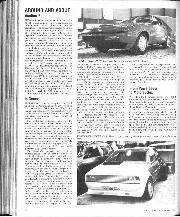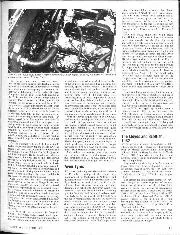

Around and about, April 1982
Auction Sale WE recently had occasion to look in on an auction sale of old cars, ranging from a veteran to cars that only recently became obsolete and out of…
THE M.G. MAGNETTE ” N “
A WELL-FINISHED LIGHT CAR WHICH REVEALS ITS RACING ORIGIN IN HIGH PERFORMANCE, GOOD ROAD HOLDING AND DELIGHTFUL HANDLING.
WHEN one bears in mind the excellence of M.G. sports cars for many years past, it may sound in the nature of hyperbole to say that, in our opinion, the ” N ” type Magnette is the most delightful car that has emanated to date from the famous Abingdon factory. This is not surprising, for it incorporates in its design, in modified form of course, many of the characteristics which have assisted the K.3 Magnette to gain its laurels in racing and record breaking. In saloon form the ” N “is called the “K.N,” and a punster could truthfully say that the Magnette is as hot-stuff as its name ! The six-cylinder engine is, in broad out
an unsupercharged version of that used in the ” K.3,” with an increased capacity of 1,287 c.c. For those who are unfamiliar with this design, we would add that the crankshaft is carried in four main bearings ; there is a single overhead camshaft, the drive of which incorporates the dynamo; the inlet and exhaust ports are on opposite sides of the head ; double valve-springs, 14 mm. plugs, and pistons of controlled-expansion type are all used. Unlike the racing ” K.3,” the ” N ” has twin S.U. carburettors and a normal type gearbox. The, rest of the car follows orthodox M.G. practice, with a strongly braced chassis frame and 12-inch brake drums. Christmas weather was hardly the most suitable variety for putting a fast car through its paces, but the Magnette is one of those rare cars in which a driver feels completely at home, whatever the conditions. The driving position is extraordinarily well thought out, so that one can sense the slightest movement of the car on a slippery corner. The steering column is actually adjustable for rake, but we found no need to alter it on collecting the car from Abingdon. The pedals are on the small side, but are far enough apart for all but the outsize in shoes. They operate smoothly and are placed at a restful angle—a point in which many cars are badly at fault. The usual M.G. type of remote-control gear lever is
used, in front of which the choke and slow-running controls are easily reached. The racing hand-brake is to our liking, enabling smooth and quick restarts to be made on steep hills. The dashboard is well panelled and equipped, but we have a slight personal criticism to make of the placing of the dials. The oil gauge and ammeter are two instruments which every driver likes to glance at occasionally on a long run, but both of these are on the extreme left, facing the passenger. Our second minor criticism applies to the combined speedometer and rev, counter, which unfortunately does not indicate the speed of the car when the indirect ratios are being used. On the other hand, revs, are the important thing. Especially useful items of dashboard equipment are the oil ther
mometer and a reserve fuel tap. A centre panel incorporates mileage and trip indicators, headlight dimming switch, and switches for the direction-signals, dashlamps and fog-lamp. Encouraged by the general charm and road worthiness of the Magnette, we set off on Boxing Day on a lightning visit to friends at Paignton, South Devon, returning to London the same day. The roads, although wet, were comfortably free from traffic, and as we made our way towards the Great West Road we felt strangely safe on the deserted Chiswick High Road, on normal days a beaconbesprinkled death-trap. We intended the trip to be an easy one, Without strain on -the driver, passengers (we were three up) or car, and the engine was allowed to find its own restful cruising speed, which proved to be 4,000 r.p.m., or 62 m.p.h. At this gait the Magnette ran with com plete effortlessness, giving the impression of consuming the least possible amount of fuel. An approximate checking of the
fuel consumption over the whole trip gave a figure of 25 miles per gallon, which is good when bearing the average speed in mind. The Stockbridge road to Salisbury was taken, and the sight of the magnificent stretches of undulating highway proved
too much for our resolutions in regard to steady driving, on more than one occasion.
The Magnette quickly reached its maximum of 80 m.p.h., at which speed the road-holding was excellent, and open curves could be taken with a trace of controllable slide. Later on, we found the good handling of the car a great asset on the winding road beyond Salisbury.
In spite of having wet roads to contend with the whole way, we arrived at Paignton at five minutes to one, having left London at ten minutes past eight197 miles in 41 hours, including a stop for petrol and another for personal refreshment—without any hurry, save for a few brief bursts of speed on the Plain. The secret of this ability to cover the ground quickly and safely lies in the Magnette’s racing ancestry. Every function of the car has been tested in races at far higher speeds than the ” N ” model is capable of, and this margin of safety is probably the car’s outstanding characteristic. The road-holding at maximum speed, for example, is so good that the driver does not have to wrestle with the steeringwheel in a life-and-death struggle to keep the car on the road. The chassis feels that it could stand another 20 m.p.h. and still be controllable.